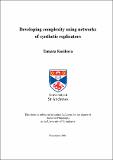Developing complexity using networks of synthetic replicators
Abstract
Molecular recognition plays an essential role in the self-assembly and self-organisation
of biological and chemical systems alike—allowing individual components to form
complex interconnected networks. Within these systems, the nature of the recognition
and reactive processes determines their functional and structural properties, and even
small changes in their identity or orientation can exert a dramatic effect on the observed
properties. The rapidly developing field of systems chemistry aims to move away
from the established paradigm in which molecules are studied in isolation, towards
the study of networks of molecules that interact and react with each other. Taking
inspiration from complex natural systems, where recognition processes never operate
in isolation, systems chemistry aims to study chemical networks with the view to
examining the system-level properties that arise from the interactions and reactions
between the components within these systems.
The work presented in this thesis aims to advance the nascent field of systems
chemistry by bringing together small organic molecules that can react and interact
together to form interconnected networks, exhibiting complex behaviour, such as self-replication, as a result. Three simple building blocks are used to construct a network
of two structurally similar replicators and their kinetic behaviour is probed through a
comprehensive kinetic analysis. The selectivity for one of the recognition-mediated
reactive processes over another is examined within the network in isolation as well as
in a scenario where the network is embedded within a pool of exchanging components.
The interconnected, two-replicator network is examined under far-from-equilibrium
reaction-diffusion conditions, showing that chemical replicating networks can exhibit
signs of selective replication—a complex phenomenon normally associated with biological
systems. Finally, a design of a well-characterised replicator is exploited for
the construction of a network integrating self-replication with a another recognition-directed
process, leading to the formation of a mechanically-interlocked architecture—a
[2]rotaxane.
Type
Thesis, PhD Doctor of Philosophy
Collections
Items in the St Andrews Research Repository are protected by copyright, with all rights reserved, unless otherwise indicated.

